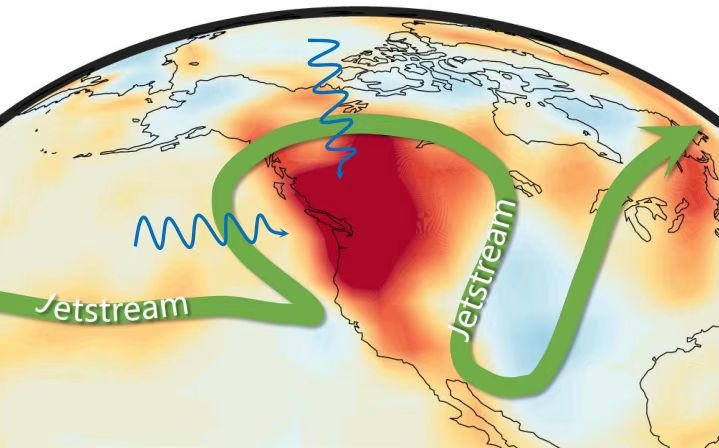By Institute of Atmospheric Physics, Chinese Academy of SciencesSeptember 8, 2022

The scientists believe that greenhouse gases are primarily responsible for the increased temperatures.
Researchers find that human activities increase the chance of more intense heat waves.
The 19th of July was the hottest day ever recorded in the United Kingdom, with temperatures exceeding 40 degrees
Shading represents surface air temperature anomalies, and the green vector denotes jetstream (a narrow band of very strong westerly air currents near the altitude of the tropopause). Two blue vectors indicate that the heatwave is related to anomalous circulations in the North Pacific and the Arctic. Credit: Jiayu Zheng
“An extraordinary and unprecedented heat wave swept western North America in late June of 2021, resulting in hundreds of deaths and a massive die-off of sea creatures off the coast as well as horrific wildfires,” said lead author Chunzai Wang, a researcher in the Southern Marine Science and Engineering Guangdong Laboratory and head of the State Key Laboratory of Tropical Oceanography at the South China Sea Institute of Oceanology, Chinese Academy of Sciences (CAS).“In this paper, we studied the physical processes of internal variabilities, such as atmospheric circulation patterns, and external forcing, such as anthropogenic greenhouse gases.”Atmospheric circulation patterns describe how air flows and impacts surface air temperatures across the world, both of which may fluctuate due to natural warming from the Sun, atmospheric internal variability, and the rotation of the Earth. These configurations are responsible for both everyday weather and the long-term trends that comprise climate. The researchers used observational data to identify three atmospheric circulation patterns that co-occurred during the 2021 heat wave: the North Pacific pattern, the Arctic-Pacific Canada pattern, and the North America pattern.“The North Pacific pattern and the Arctic-Pacific Canada pattern co-occurred with the development and mature phases of the heat wave, whereas the North America pattern coincided with the decaying and eastward movements of the heat wave,” Wang said. “This suggests the heat wave originated from the North Pacific and the Arctic, while the North America pattern ushered the heat wave out.”However, atmospheric circulation patterns could co-occur – and have in the past – without causing an extreme heat wave, so how much of the 2021 event was influenced by human activity? Wang and his colleagues employed the World Climate Research Programme’s internationally curated, tested, and assessed models, particularly the Detection Attribution Model Comparison models of the Coupled Model Intercomparison Project Phase 6 (CMIP6).“From the CMIP6 models, we found that it is likely that global warming associated with greenhouse gases influences these three atmospheric circulation pattern variabilities, which, in turn, led to a more extreme heat wave event,” Wang said. “If appropriate measures are not taken, the occurrence probability of extreme heat waves will increase and further impact the ecological balance, as well as sustainable social and economic development.”Reference: “Unprecedented Heatwave in Western North America during Late June of 2021: Roles of Atmospheric Circulation and Global Warming” by Chunzai Wang, Jiayu Zheng, Wei Lin and Yuqing Wang, 22 July 2022, Advances in Atmospheric Sciences.
DOI: 10.1007/s00376-022-2078-2


